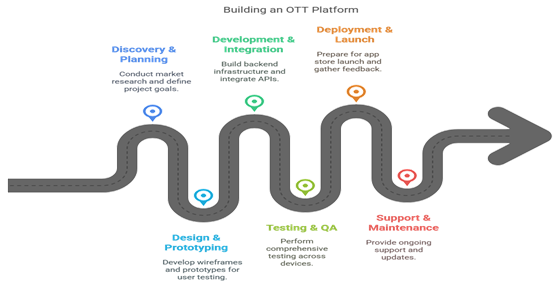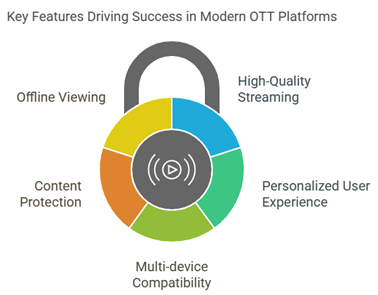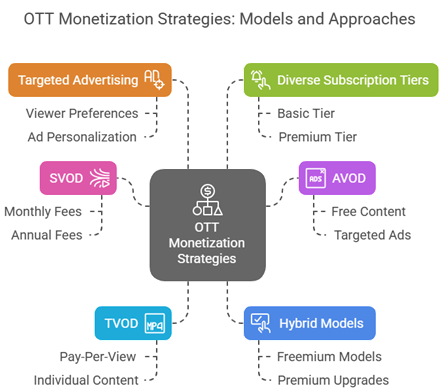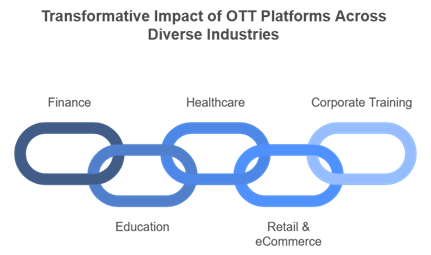In today’s digital age, Over-The-Top (OTT) streaming services have revolutionized how we consume media and entertainment. These platforms deliver content directly to viewers via the internet, bypassing traditional distribution channels like cable or satellite TV. Let’s explore the world of OTT streaming services and how they’re reshaping the future of entertainment.
What Are OTT Streaming Services?
OTT (Over-The-Top) refers to content providers that distribute streaming media directly to viewers over the internet. Unlike traditional media distribution models, OTT platforms allow users to access content on-demand through various internet-connected devices such as smartphones, tablets, smart TVs, and gaming consoles.
The power of OTT lies in its flexibility and convenience. Users can watch what they want, when they want, and where they want without the constraints of broadcast schedules or physical media.
The OTT App Development Process

Creating a successful OTT platform involves a structured development process that ensures quality, performance, and user satisfaction. Here’s how the lifecycle typically unfolds:
1. Discovery and Planning
The journey begins with thorough market research to understand user preferences and competitor offerings. This phase involves defining clear project goals, creating detailed project roadmaps with milestones, and collaborating with stakeholders to align expectations.
2. Design and Prototyping
This crucial phase involves developing wireframes and user flows to visualize app navigation. Interactive prototypes help test usability and gather early feedback, while intuitive UI/UX interfaces are designed to enhance user engagement and reflect brand identity. Responsive design ensures consistency across all devices.
3. Development and Integration
Developers build a scalable backend infrastructure for content management and delivery, develop front-end applications using cutting-edge technologies, integrate third-party APIs for functionalities like payments and analytics, and implement secure authentication protocols.
4. Testing and Quality Assurance
Comprehensive testing across multiple devices, browsers, and operating systems ensures platform reliability. This includes functional testing, usability testing, and implementing automated testing scripts to streamline the process.
5. Deployment and Launch
The launch phase involves preparing app store listings, coordinating marketing campaigns, monitoring performance metrics, and gathering initial user feedback.
6. Support and Maintenance
Post-launch support includes helpdesk services, regular maintenance to address bugs, implementing updates based on user feedback, and ensuring the platform can scale to accommodate growth.
Essential Features of Modern OTT Platforms

Today’s competitive OTT landscape demands a robust feature set to attract and retain users:
- High-Quality Streaming: Smooth playback with minimal buffering across devices
- Personalized User Experience: Recommendation engines and user profiles
- Multi-device Compatibility: Seamless experience across smartphones, tablets, smart TVs, and web browsers
- Content Protection: DRM and security measures to safeguard intellectual property
- Offline Viewing: Download capabilities for on-the-go consumption
- Interactive Features: User engagement tools like comments, ratings, and social sharing
- Analytics Dashboard: Insights into viewer behavior and content performance
- Multiple Monetization Options: Subscription models, advertising, and pay-per-view options
OTT Monetization Strategies

Effective monetization is crucial for OTT platform sustainability. Key strategies include:
- Subscription Video on Demand (SVOD): Monthly or annual subscription fees for unlimited access
- Advertising Video on Demand (AVOD): Free content supported by targeted advertisements
- Transactional Video on Demand (TVOD): Pay-per-view model for individual content pieces
- Hybrid Models: Combining multiple approaches, such as freemium models with premium upgrades
- Targeted Advertising: Personalized ad delivery based on viewer preferences
- Diverse Subscription Tiers: Multiple pricing levels with varying features and content access
Industry Applications Beyond Entertainment

While entertainment remains the most visible OTT application, these platforms are transforming numerous other industries:
Finance
Financial institutions use OTT platforms to deliver financial literacy programs, market updates, and personalized investment advice.
Education
Educational institutions leverage OTT solutions for remote learning with video lectures, interactive courses, and accessible educational content.
Healthcare
Telemedicine apps enable virtual consultations, patient monitoring, and health education through secure streaming platforms.
Retail & eCommerce
OTT solutions enhance the shopping experience through product demonstrations, tutorials, and live streaming to boost customer engagement.
Corporate Training
Businesses utilize OTT platforms for employee training, delivering on-demand videos, webinars, and certification programs.
Sports
Dedicated sports streaming apps offer live games, highlights, and interactive features to enhance global fan engagement.
Travel & Hospitality
Virtual tours, destination guides, and immersive experiences help travelers plan and preview their journeys.
Technical Considerations for OTT Platforms
Building a robust OTT platform requires attention to several technical aspects:
Content Delivery Network (CDN)
A global CDN ensures fast, reliable content delivery regardless of viewer location by distributing content across multiple servers.
Video Encoding and Transcoding
Adaptive bitrate streaming technologies optimize video quality based on the viewer’s internet connection and device capabilities.
Cloud Infrastructure
Scalable cloud solutions accommodate fluctuating user demand and growing content libraries.
Security and DRM
Protecting content from piracy through digital rights management and encryption is essential for premium content.
Analytics and AI
Data-driven insights help platforms understand viewer preferences, while AI powers recommend engines that increase engagement.
The Future of OTT Streaming
As technology continues to evolve, so will OTT platforms. Here are some trends shaping the future:
- Interactive Content: Branching narratives and user-influenced storylines
- AI-Powered Personalization: Ultra-precise content recommendations based on viewing habits
- AR/VR Integration: Immersive viewing experiences beyond traditional screens
- Social Viewing Features: Virtual watch parties and community engagement tools
- Improved Content Discovery: Advanced search and categorization to help users find relevant content
- 5G Impact: Ultra-low latency streaming for live events and improved mobile viewing
Conclusion
OTT streaming services have fundamentally changed how we consume media and will continue to evolve as technology advances. For businesses looking to enter this space, partnering with experienced OTT development teams can help navigate the complexities of platform creation, from initial concept to post-launch support.
The future of entertainment is streaming, and the opportunities for innovation in this space are virtually limitless. Whether you’re a content creator, media company, or business looking to leverage video for engagement, the OTT revolution offers exciting possibilities for connecting with audiences in new and meaningful ways.
By embracing the technological capabilities and user-centric design principles of modern OTT development, organizations can create streaming experiences that captivate audiences and drive business growth in the digital age.